美国膳食补充剂健康与教育法_DSHEA1994_简介
药品注册用英语
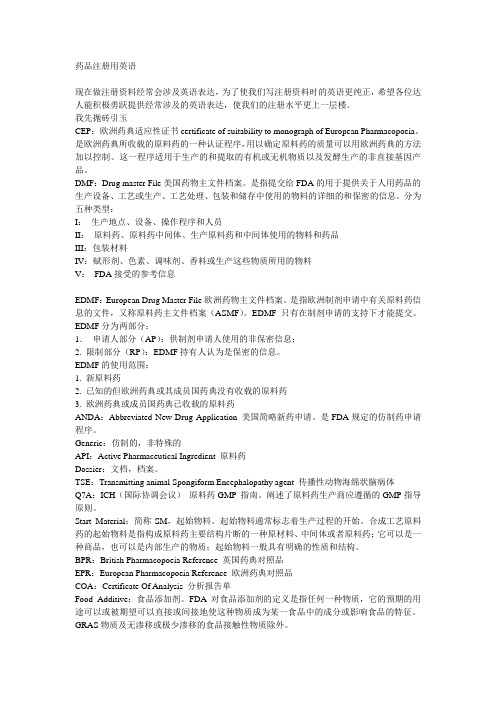
药品注册用英语现在做注册资料经常会涉及英语表达,为了使我们写注册资料时的英语更纯正,希望各位达人能积极勇跃提供经常涉及的英语表达,使我们的注册水平更上一层楼。
我先抛砖引玉CEP:欧洲药典适应性证书certificate of suitability to monograph of European Pharmacopoeia。
是欧洲药典所收载的原料药的一种认证程序,用以确定原料药的质量可以用欧洲药典的方法加以控制。
这一程序适用于生产的和提取的有机或无机物质以及发酵生产的非直接基因产品。
DMF:Drug master File美国药物主文件档案。
是指提交给FDA的用于提供关于人用药品的生产设备、工艺或生产、工艺处理、包装和储存中使用的物料的详细的和保密的信息。
分为五种类型:I:生产地点、设备、操作程序和人员II:原料药、原料药中间体、生产原料药和中间体使用的物料和药品III:包装材料IV:赋形剂、色素、调味剂、香料或生产这些物质所用的物料V:FDA接受的参考信息EDMF:European Drug Master File欧洲药物主文件档案。
是指欧洲制剂申请中有关原料药信息的文件,又称原料药主文件档案(ASMF)。
EDMF 只有在制剂申请的支持下才能提交。
EDMF分为两部分:1.申请人部分(AP):供制剂申请人使用的非保密信息;2. 限制部分(RP):EDMF持有人认为是保密的信息。
EDMF的使用范围:1. 新原料药2. 已知的但欧洲药典或其成员国药典没有收载的原料药3. 欧洲药典或成员国药典已收载的原料药ANDA:Abbreviated New Drug Application 美国简略新药申请。
是FDA规定的仿制药申请程序。
Generic:仿制的,非特殊的API:Active Pharmaceutical Ingredient 原料药Dossier:文档,档案。
TSE:Transmitting animal Spongiform Encephalopathy agent 传播性动物海绵状脑病体Q7A:ICH(国际协调会议)原料药GMP 指南。
关于美国“新膳食成分”备案指南的修订草案
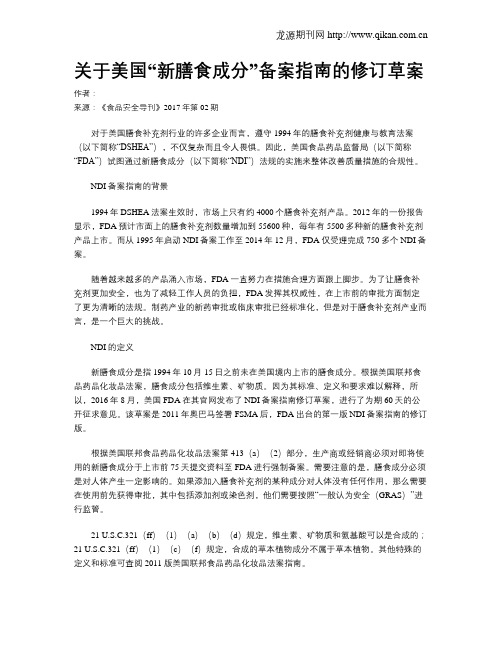
关于美国“新膳食成分”备案指南的修订草案作者:来源:《食品安全导刊》2017年第02期对于美国膳食补充剂行业的许多企业而言,遵守1994年的膳食补充剂健康与教育法案(以下简称“DSHEA”),不仅复杂而且令人畏惧。
因此,美国食品药品监督局(以下简称“FDA”)试图通过新膳食成分(以下简称“NDI”)法规的实施来整体改善质量措施的合规性。
NDI备案指南的背景1994年DSHEA法案生效时,市场上只有约4000个膳食补充剂产品。
2012年的一份报告显示,FDA预计市面上的膳食补充剂数量增加到55600种,每年有5500多种新的膳食补充剂产品上市。
而从1995年启动NDI备案工作至2014年12月,FDA仅受理完成750多个NDI备案。
随着越来越多的产品涌入市场,FDA一直努力在措施合理方面跟上脚步。
为了让膳食补充剂更加安全,也为了减轻工作人员的负担,FDA发挥其权威性,在上市前的审批方面制定了更为清晰的法规。
制药产业的新药审批或临床审批已经标准化,但是对于膳食补充剂产业而言,是一个巨大的挑战。
NDI的定义新膳食成分是指1994年10月15日之前未在美国境内上市的膳食成分。
根据美国联邦食品药品化妆品法案,膳食成分包括维生素、矿物质。
因为其标准、定义和要求难以解释,所以,2016年8月,美国FDA在其官网发布了NDI备案指南修订草案,进行了为期60天的公开征求意见。
该草案是2011年奥巴马签署FSMA后,FDA出台的第一版NDI备案指南的修订版。
根据美国联邦食品药品化妆品法案第413(a)(2)部分,生产商或经销商必须对即将使用的新膳食成分于上市前75天提交资料至FDA进行强制备案。
需要注意的是,膳食成分必须是对人体产生一定影响的。
如果添加入膳食补充剂的某种成分对人体没有任何作用,那么需要在使用前先获得审批,其中包括添加剂或染色剂,他们需要按照“一般认为安全(GRAS)”进行监管。
21 U.S.C.321(ff)(1)(a)(b)(d)规定,维生素、矿物质和氨基酸可以是合成的;21 U.S.C.321(ff)(1)(c)(f)规定,合成的草本植物成分不属于草本植物。
浅谈美国保健品市场的法规要求及应对策略
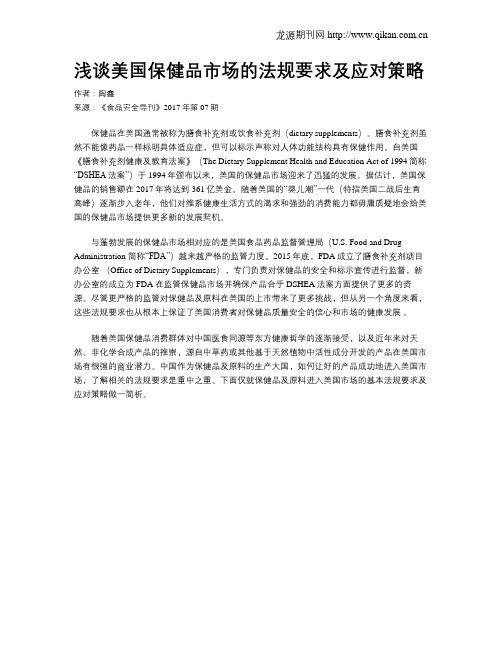
浅谈美国保健品市场的法规要求及应对策略作者:陶鑫来源:《食品安全导刊》2017年第07期保健品在美国通常被称为膳食补充剂或饮食补充剂(dietary supplements)。
膳食补充剂虽然不能像药品一样标明具体适应症,但可以标示声称对人体功能结构具有保健作用。
自美国《膳食补充剂健康及教育法案》(The Dietary Supplement Health and Education Act of 1994简称“DSHEA法案”)于1994年颁布以来,美国的保健品市场迎来了迅猛的发展。
据估计,美国保健品的销售额在2017年将达到361亿美金。
随着美国的“婴儿潮”一代(特指美国二战后生育高峰)逐渐步入老年,他们对维系健康生活方式的渴求和强劲的消费能力都毋庸质疑地会给美国的保健品市场提供更多新的发展契机。
与蓬勃发展的保健品市场相对应的是美国食品药品监督管理局(U.S. Food and Drug Administration 简称“FDA”)越来越严格的监管力度。
2015年底,FDA成立了膳食补充剂项目办公室(Office of Dietary Supplements),专门负责对保健品的安全和标示宣传进行监督,新办公室的成立为FDA在监管保健品市场并确保产品合乎DSHEA法案方面提供了更多的资源。
尽管更严格的监管对保健品及原料在美国的上市带来了更多挑战,但从另一个角度来看,这些法规要求也从根本上保证了美国消费者对保健品质量安全的信心和市场的健康发展。
随着美国保健品消费群体对中国医食同源等东方健康哲学的逐渐接受,以及近年来对天然、非化学合成产品的推崇,源自中草药或其他基于天然植物中活性成分开发的产品在美国市场有很强的商业潜力。
中国作为保健品及原料的生产大国,如何让好的产品成功地进入美国市场,了解相关的法规要求是重中之重。
下面仅就保健品及原料进入美国市场的基本法规要求及应对策略做一简析。
DSHEA法案如何定义“膳食补充剂”作为保健品,合法在美销售的最基本要求是明确产品符合DSEHA法案中膳食补充剂的定义。
汤臣倍健在中国市场营销战略分析—毕业设计论文
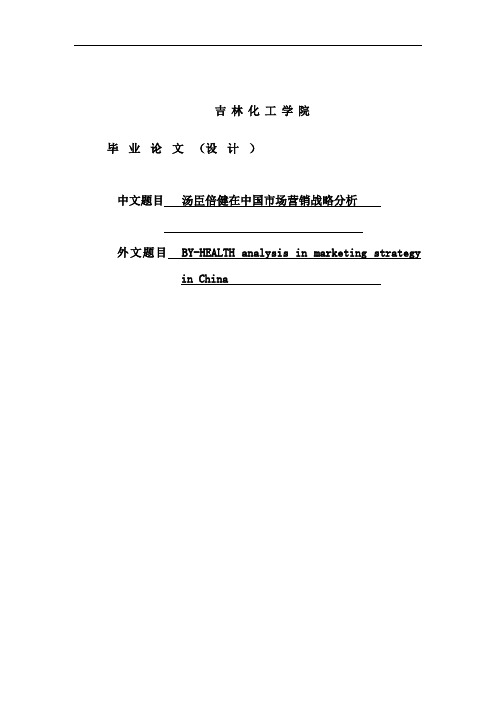
吉林化工学院毕业论文(设计)中文题目汤臣倍健在中国市场营销战略分析外文题目 BY-HEALTH analysis in marketing strategy in China摘要随着我国市场经济的日趋成熟和完善,保健品行业竞争也日益激烈。
在压力和机遇并存的大环境下,构建和疏通企业自己的营销策略对汤臣倍健来说,就显得尤为重要。
汤臣倍健营销策略研究通过对保健品行业现状和发展趋势进行分析,针对汤臣倍健营销策略中常出现的问题,从产品策略、价格策略、渠道策略、促销策略四个方面分析汤臣倍健营销策略现状,并针对汤臣倍健产品策略、价格策略、渠道策略、促销策略存在的问题,提出一套适宜汤臣倍健的营销策略和管理的具体办法,希望能为汤臣倍健营销策略和管理提供借鉴,为其扩大市场占有率、创建国内国际知名品牌打下坚实的基础,我国的保健品企业营销陈旧,属于典型的生产型观念,服务意识淡薄,缺乏准确的“服务定位”营销渠道单一几乎没有采取任何促销手段和措施,因此有必要对保健品企业的营销进行研究。
关键词:保健品;汤臣倍健;营销策略AbstractAlong with our country market economy matures and perfect, commodity industry has become intense competition. With the pressure and with the opportunity of the environment, build and dredge enterprise marketing strategy to Amway, it is particularly important. Amway marketing strategy based on the present situation and the development trend of the commodity industry analysis, in view of the Amway marketing strategy often appears the question, from product strategy, price strategy, channel strategy, promotion strategy four aspects analysis Amway marketing strategy status in Amway product strategy, price strategy, channel strategy, promotion strategy existing problems, and puts forward a set of suitable Amway marketing strategy and management of the specific measures, the hope can Amway marketing strategy and management, to provide reference for the expanding market share, create international well-known brand in domestic and lay a solid foundation. China's health care products enterprise marketing obsolete, belongs to the typical production concept, service consciousness, lack of accurate "service orientation" marketing channel single almost didn't take any promotion means and measures, so it is necessary to health care productsenterprise marketing research.Key words: Commodity;Amway;Marketing strategy目录摘要 (2)Abstract (3)第1章绪论 (4)1.1 研究背景 (5)1.2 研究的目的和意义 (6)1.3 国内外研究现状 (6)1.4 研究内容与研究方法 (9)第2章相关理论概述 (8)2.1 营销策略概念 (9)2.2 营销策略的类型 (9)第3章汤臣倍健保健品品有限公司营销现状 (10)3.1 汤臣倍健产品策略现状 (12)3.2 汤臣倍健价格策略现状 (12)3.3 汤臣倍健渠道策略现状 (13)3.4 汤臣倍健促销策略现状 (17)第4章汤臣倍健有限公司营销策略存在问题 (14)4.1 汤臣倍健产品策略存在的问题 (18)4.2 汤臣倍健价格策略存在的问题 (18)4.3 汤臣倍健渠道策略存在的问题 (19)4.4 汤臣倍健促销策略存在的问题 (21)第5章汤臣倍健营销策略改良 (17)5.1 汤臣倍健产品营销策略改良 (22)5.2 汤臣倍健价格营销策略改良 (22)5.3 汤臣倍健渠道营销策略改良 (23)5.4 汤臣倍健促销营销策略改良 (24)结论 (25)参考文献 (27)致谢 (29)第1章绪论1.1研究背景市场是由具有购买欲望和购买能力的消费群体组成,中国是一个拥有1亿9千多万人口的巨大市场。
5-1运动营养补充剂

营造肌肉蛋白质合成最佳激素环境
例:蒺藜皂苷和蒺藜提取物、锌、硼、传统的 补肾中药以及目前通过兴奋检测的中药产品等
2例:膳食替代粉、能量棒或能量胶、肌酸、 1-6二磷酸果糖、肉碱、牛磺酸等
3、预防损伤、延缓疲劳和促进体能恢复的运 动营养补充剂。
如:维生素C、谷氨酰胺、、氨基葡萄糖、碳 酸氢钠等。
我国对运动营养补充剂的称谓有很多,如运 动营养品、强力营养素、强力营养物质、高 效运动营养因子、运动营养保健品、运动营 养补充剂等。
二、按功效分类 1、增加肌肉蛋白质合成的运动营养补充剂 2、提供能量或促进代谢的运动营养补充剂 3、预防损伤、延缓疲劳和促进体能恢复的 特殊运动营养补充剂。
1、增加肌肉蛋白质合成代谢的运动营养补充剂 例:乳清蛋白、大豆蛋白、氨基酸、活性肽等
1994年美国通过膳食补充剂健康与教育法案具有强力作用的膳食补充剂被理解为运动营养补充剂我国对运动营养补充剂的称谓有很多如运动营养品强力营养素强力营养物质高效运动营养因子运动营养保健品运动营养补充剂等
运动营养补充剂
一、概念 目前无统一概念。
美国将运动营养补充剂归于膳食补充剂 的范畴。
1994年美国通过《膳食补充剂、健康与教 育法案》具有强力作用的膳食补充剂被理 解为运动营养补充剂
三、运动营养补充剂的使用原则
1、在严格的科学指导下使用 2、具有明确的功效原理,且必须是合法的 3、具有安全性 4、注意个人差异 5、不能取代运动训练
ndi疗效标准

ndi疗效标准NDI(New Dietary Ingredient)是指在1994年10月15日美国《1994年补充剂法案》(DSHEA)颁布以前在美国市场上没有销售过的膳食成分或混合物,或者在法案颁布前销售过但具有新的用途、用量或方法的成分或混合物。
为了保护消费者的健康,确保市场上的膳食补充剂安全有效,美国食品药品监督管理局(FDA)制定了一系列的疗效标准,以规范NDI的使用和销售。
这些疗效标准主要包括以下几个方面:1. 安全性评估:所有NDI都需要经过严格的安全性评估。
供应商需要提供充分的科学数据,包括毒理学研究、人体试验等,以证明该成分或混合物在建议用量下不会对人体健康造成危害。
评估还需要考虑人群的不同特点,如年龄、性别、生理状况等。
2. 活性成分标识:供应商需要准确地标明NDI产品中所含的活性成分,并提供相应的质量控制标准。
这有助于确保消费者获得的产品具有一致的成分含量和质量,避免虚假宣传或误导消费者。
3. 临床证据支持:供应商需要提供充足的临床证据来支持其NDI产品的疗效主张。
这包括严格的研究设计、足够的样本量、随机对照试验等。
只有在通过科学研究证明该产品能够达到预期的疗效后,才能合法销售。
4. 产品标签规范:所有销售NDI的产品都需要在标签上明确标注其成分、用量和疗效主张,并提供产品使用说明和警示。
标签上的信息需要准确、明确,以确保消费者能够正确使用并了解产品的功效和限制。
5. 质量控制和生产标准:供应商需要建立完善的质量控制和生产标准,以确保其NDI产品的质量和稳定性。
这包括选择高质量的原材料供应商、建立严格的生产流程、进行必要的测试和验证等。
只有符合质量标准的产品才能合法销售。
以上是美国FDA对NDI的疗效标准的基本内容。
除了上述方面,为了进一步加强对NDI产品的监管,FDA还持续进行着市场监测、临床试验数据的审核和评估等。
虽然以上疗效标准主要适用于美国市场,但对于其他国家和地区的膳食补充剂制造商和销售商来说,也是一个重要的参考。
美国膳食营养补充品监管
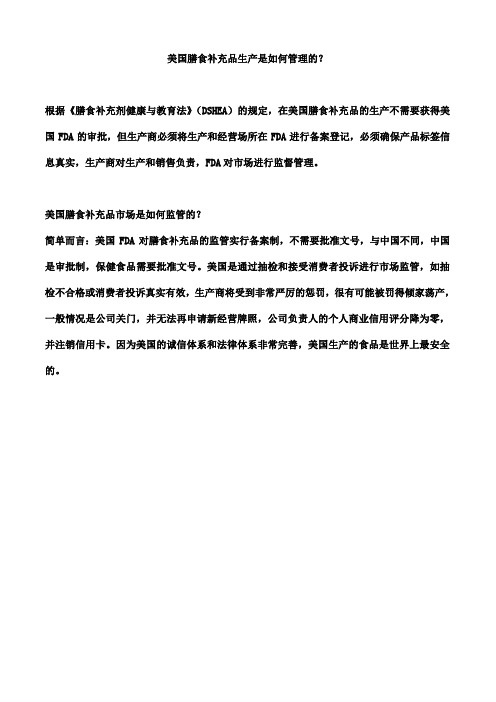
美国膳食补充品生产是如何管理的?
根据《膳食补充剂健康与教育法》(DSHEA)的规定,在美国膳食补充品的生产不需要获得美国FDA的审批,但生产商必须将生产和经营场所在FDA进行备案登记,必须确保产品标签信息真实,生产商对生产和销售负责,FDA对市场进行监督管理。
美国膳食补充品市场是如何监管的?
简单而言:美国FDA对膳食补充品的监管实行备案制,不需要批准文号,与中国不同,中国是审批制,保健食品需要批准文号。
美国是通过抽检和接受消费者投诉进行市场监管,如抽检不合格或消费者投诉真实有效,生产商将受到非常严厉的惩罚,很有可能被罚得倾家荡产,一般情况是公司关门,并无法再申请新经营牌照,公司负责人的个人商业信用评分降为零,并注销信用卡。
因为美国的诚信体系和法律体系非常完善,美国生产的食品是世界上最安全的。
国外植物药研研究与开发

化学合成药研究开发的方式
化学合成药开发的基础是研究治疗靶点的生物靶分 子的结构和功能,在此基础上来设计合成药物,或通过 对现有某些药物小分子的结构进行修饰,然后再经过动 物药理、毒理试验(临床前试验),但最后要检验的仍 是对病人的疗效与安全性(临床试验)。
这种模式优点是治疗靶点针对性强,量效确切,作 用机制相对清楚,然而也有着不容回避的缺点是开发的 主观盲目、周期长、耗资大、风险大。
14
从银杏叶中提取药物成分从20 世纪开始, 经历了4 代: 第1 代: 银杏叶制剂的有效成分含量低于16%, 只能作为保 健品, 无药理作用, 一般为银杏叶茶。 第2 代: 银杏叶产品, 其有效成分为16%的银杏黄酮。 第3 代: 银杏叶产品, 可含24%的银杏黄酮, 其药理作用均为清除 自由基, 目前许多银杏叶制剂处于这一阶段。 第4 代:银杏叶制剂要求: ①提取浓缩比例为50∶1(50 份干燥 银杏叶中提取1份银杏叶提取物); ②银杏叶酸的含量<5 ppm(1/10 万单位); ③含24%的银杏黄酮、6%的萜类( 3.1% 的银杏内酯、2.9%的白果内酯)。第4 代银杏叶制剂的药理作用 : ①清除自由基; ②拮抗血小板活化因子; ③保护神经细胞。目前 只有德国威玛舒培博士药厂生产的金纳多符合这一条件。
6
很多国内外制药公司都重视对新药的研究和开发,研究 经费占药品销售额的8%~10%。研究内容包括:新化 合物的合成,动物筛选,动物治疗试验,毒性试验和毒 理学研究,药物代谢与动力学研究,分析研究和质量标 准的制订,健康人的药理试验,临床试验,制剂研究, 合成工艺研究,等等。化学合成药物开发的成本高,开 发周期长。据统计,世界药品研究开发的年费用已超过 400亿美元,比1982年的54亿美元上升了8倍。
膳食补充剂CGMP知识培训1

新提案要求食品工厂人员对卫生问题调查负责,并对食品污染有相关的教育经历。 食品处理者和监管人必须要经过适当的食品处理技术培训,在操作前需要告知其不卫生 操作有可能带来的危险。
这项新提案要求工厂的员工最好有能力胜任这份工作并且经过良好的培训。
cGMP:英文Current Good Manufacturing Practice 的缩写,是“良好操作规范”。 cGMP是指加工生产膳食补充剂、食品、医药材料、药品、生物制品以及兽医产品要 求的方法、系统、设备、设施及控制手段的规定和法规。 cGMP是食品生产企业实现生产工艺合理化、科学化、现代化的首要条件。 2007 年FDA 发布了21CFR Part 111是膳食补充剂的cGMP最终规范要求。
第一部法案:1906年美国颁布的《纯净食品和化妆品法》,此法律主要是禁止冒用商 标和洲际间及国外贸易运输掺假食品。
第一次世界大战期间,美国新闻界披露美国食品工业的不良状况和药品生产的欺骗行 径之后,美国1938年《食品、药品和化妆品法》取代了《纯净食品和化妆品法》,开 始以法律形式来保证食品、药品的质量,建立了世界上第一个国家级的食品药品管理 机构——美国食品药品管理局(FDA)。
2011年1月4日由奥巴马总统签署《食品安全现代法》后, 《食品安全现代化 法》赋予FDA前所未有的授权。 按照《规定》要求,美国在法规公布后3年内,对所有生产和销售维生素/矿 物质制剂、植物类制剂和各种膳食补充剂的美国本土公司强制实施cGMP改造。 最迟在5年里,要全部完成对cGMP改造工作。
凡是出口到美国的食品原料,都必须要有当地权威机构的检测报告,而这一规定是过 去所没有的。
制作人:蒋江红
二战间数次较大药物灾难→成品抽样分析有缺陷,不能保证药品安全。
美国营养法简介
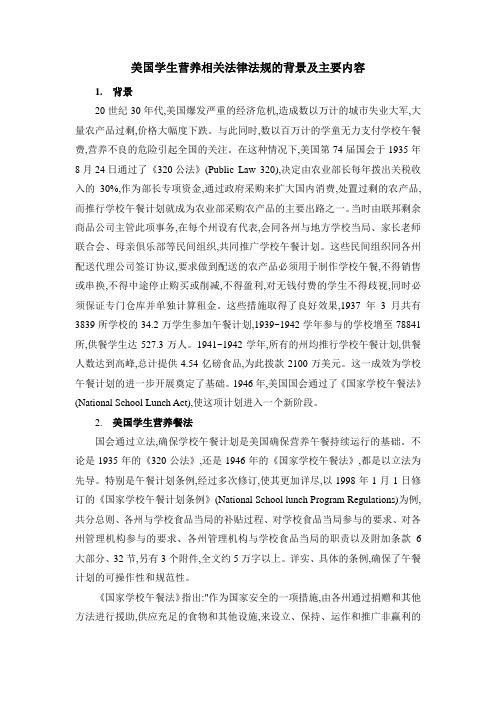
美国学生营养相关法律法规的背景及主要内容1.背景20世纪30年代,美国爆发严重的经济危机,造成数以万计的城市失业大军,大量农产品过剩,价格大幅度下跌。
与此同时,数以百万计的学童无力支付学校午餐费,营养不良的危险引起全国的关注。
在这种情况下,美国第74届国会于1935年8月24日通过了《320公法》(Public Law 320),决定由农业部长每年拨出关税收入的30%,作为部长专项资金,通过政府采购来扩大国内消费,处置过剩的农产品,而推行学校午餐计划就成为农业部采购农产品的主要出路之一。
当时由联邦剩余商品公司主管此项事务,在每个州设有代表,会同各州与地方学校当局、家长老师联合会、母亲俱乐部等民间组织,共同推广学校午餐计划。
这些民间组织同各州配送代理公司签订协议,要求做到配送的农产品必须用于制作学校午餐,不得销售或串换,不得中途停止购买或削减,不得盈利,对无钱付费的学生不得歧视,同时必须保证专门仓库并单独计算租金。
这些措施取得了良好效果,1937年3月共有3839所学校的34.2万学生参加午餐计划,1939~1942学年参与的学校增至78841所,供餐学生达527.3万人。
1941~1942学年,所有的州均推行学校午餐计划,供餐人数达到高峰,总计提供4.54亿磅食品,为此拨款2100万美元。
这一成效为学校午餐计划的进一步开展奠定了基础。
1946年,美国国会通过了《国家学校午餐法》(National School Lunch Act),使这项计划进入一个新阶段。
2.美国学生营养餐法国会通过立法,确保学校午餐计划是美国确保营养午餐持续运行的基础。
不论是1935年的《320公法》,还是1946年的《国家学校午餐法》,都是以立法为先导。
特别是午餐计划条例,经过多次修订,使其更加详尽,以1998年1月1日修订的《国家学校午餐计划条例》(National School lunch Program Regulations)为例,共分总则、各州与学校食品当局的补贴过程、对学校食品当局参与的要求、对各州管理机构参与的要求、各州管理机构与学校食品当局的职责以及附加条款6大部分、32节,另有3个附件,全文约5万字以上。
fda 保健品标准
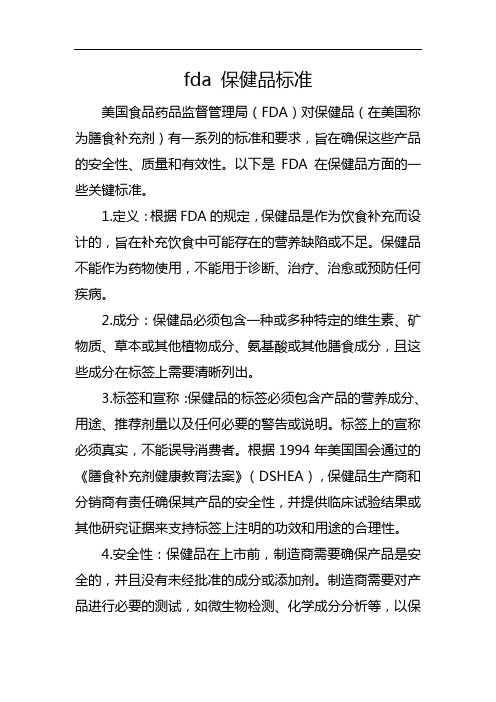
fda 保健品标准美国食品药品监督管理局(FDA)对保健品(在美国称为膳食补充剂)有一系列的标准和要求,旨在确保这些产品的安全性、质量和有效性。
以下是FDA在保健品方面的一些关键标准。
1.定义:根据FDA的规定,保健品是作为饮食补充而设计的,旨在补充饮食中可能存在的营养缺陷或不足。
保健品不能作为药物使用,不能用于诊断、治疗、治愈或预防任何疾病。
2.成分:保健品必须包含一种或多种特定的维生素、矿物质、草本或其他植物成分、氨基酸或其他膳食成分,且这些成分在标签上需要清晰列出。
3.标签和宣称:保健品的标签必须包含产品的营养成分、用途、推荐剂量以及任何必要的警告或说明。
标签上的宣称必须真实,不能误导消费者。
根据1994年美国国会通过的《膳食补充剂健康教育法案》(DSHEA),保健品生产商和分销商有责任确保其产品的安全性,并提供临床试验结果或其他研究证据来支持标签上注明的功效和用途的合理性。
4.安全性:保健品在上市前,制造商需要确保产品是安全的,并且没有未经批准的成分或添加剂。
制造商需要对产品进行必要的测试,如微生物检测、化学成分分析等,以保证产品质量和安全性。
5.生产质量:保健品的生产过程需要遵循良好的生产规范(GMPs),以确保产品的纯度、强度和成分的一致性。
6.监管:尽管保健品的监管不如药品那么严格,但FDA 仍会对市场上的保健品进行监管,包括对生产设施的检查、产品的抽样检验以及对不良事件的调查。
7.透明度和可追溯性:为了增强消费者信心和产品透明度,FDA推出了《保健品成分目录》查询服务,允许公众查询保健品中使用的成分,了解FDA对这些成分的看法和行动。
需要注意的是,FDA并不对保健品进行“认证”程序,而是要求制造商遵守上述规定,以确保产品的合规性。
如果制造商或分销商未能遵守这些规定,FDA可以采取行动,包括发出警告信、召回产品,甚至在某些情况下提起诉讼。
世界各国的保健食品监管

世界各国的保健食品监管保健食品是指声称具有特定保健食品功能或以补充维生素矿物质为目的的食品,介于普通食品和药品之间。
与普通食品相比,保健食品可以声称特定的保健功能,有每日服用量。
又不同于药品,保健食品主要用于调节人体机能,不能宣称以治疗为目的。
鉴于保健食品的特殊地位,各国对其监管各不相同。
有的国家按特殊食品监管,有的国家按药品监管,还有的国家将保健食品一分为二,分别按普通食品和药品监管。
但有一点是相同的,各国对保健食品的监管严于普通食品,但较西药和中成药宽松。
为方便大家了解各国对保健食品的监管现状,食品伙伴网简要汇总了各国的保健食品监管机构和主要法规。
1.美国1994年,美国颁布《膳食补充剂健康教育法》(The Dietary Supplement Health and Education Act, DSHEA),建立了一个新的膳食补充剂安全和标签监管框架。
法规规定,膳食补充剂是一种旨在补充膳食的产品,包含一种或多种膳食原料,如维生素、矿物质、中草药、氨基酸或其它生物活性物质。
美国FDA食品安全与应用营养中心(CFSAN)负责膳食补充剂的监管。
FDA 指出,膳食补充剂是一种食品,但如果某种膳食补充剂符合药品的定义,将会作为药品管理。
另外,《美国药典-处方集》(USP-NF)规范了膳食补充剂辅料,包括产品和成分的特性、效力、质量和纯度。
2.欧盟2002年,欧盟发布膳食补充剂法令DIRECTIVE 2002/46/EC,规定了可用于膳食补充剂的维生素和矿物质。
法令规定,膳食补充剂属于食品,由维生素、矿物质及其他物质组成,不含过多的热量,目的是补充正常膳食供给的不足,但不能替代正常的膳食,其销售的剂量形式上可以是胶囊、锭剂、片剂、丸剂或其他相似形式,如包状粉剂、液体安瓿剂和滴剂等小单位量形式的一类物质。
3.澳大利亚在食品和药品之间存在着一类在安全和功效方面与药品有交叉的产品,澳大利亚把这类产品归类为补充药品(Complementary medicines),包括草药、维生素、矿物质、营养补充剂、芳香性植物油和顺势疗法产品。
Dietary Supplement Health and Education Act of 1994(美国膳食补充剂健康与教育法)
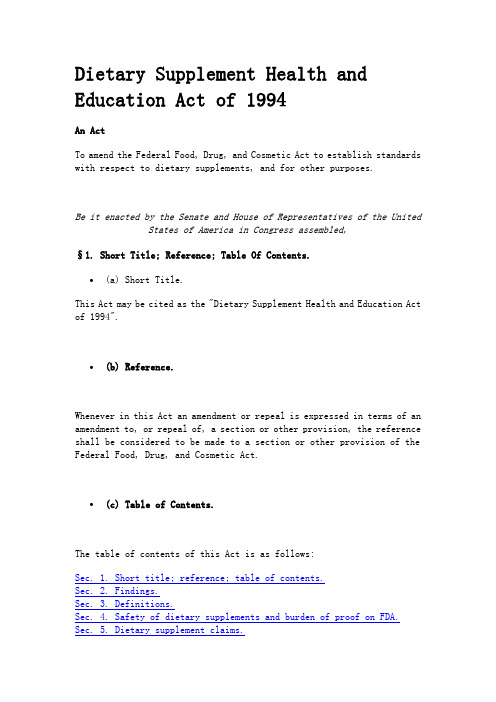
Dietary Supplement Health and Education Act of 1994An ActTo amend the Federal Food, Drug, and Cosmetic Act to establish standards with respect to dietary supplements, and for other purposes.Be it enacted by the Senate and House of Representatives of the United States of America in Congress assembled,§1. Short Title; Reference; Table Of Contents.∙(a) Short Title.This Act may be cited as the "Dietary Supplement Health and Education Act of 1994".∙(b) Reference.Whenever in this Act an amendment or repeal is expressed in terms of an amendment to, or repeal of, a section or other provision, the reference shall be considered to be made to a section or other provision of the Federal Food, Drug, and Cosmetic Act.∙(c) Table of Contents.The table of contents of this Act is as follows:Sec. 1.Short title; reference; table of contents.Sec. 2.Findings.Sec. 3.Definitions.Sec. 4.Safety of dietary supplements and burden of proof on FDA.Sec. 5. Dietary supplement claims.Sec. 6.Statements of nutritional support.Sec. 7.Dietary supplement ingredient labeling and nutrition information labeling.Sec. 8.New dietary ingredients.Sec. 9. Good manufacturing practices.Sec. 10.Conforming amendments.Sec. 11.Withdrawal of the regulations and notice.Sec. mission on dietary supplement labels.Sec. 13.Office of dietary supplements.§2. Findings.Congress finds that -∙(1) improving the health status of United States citizens ranks at the top of the national priorities of the Federal Government;∙(2) the importance of nutrition and the benefits of dietary supplements to health promotion and disease prevention have been documented increasingly in scientific studies;∙(3)(A) there is a link between the ingestion of certain nutrients or dietary supplements and the prevention of chronic diseases such as cancer, heart disease, and osteoporosis; and∙(B) clinical research has shown that several chronic diseases can be prevented simply with a healthful diet, such as a diet that is low in fat, saturated fat, cholesterol, and sodium, with a high proportion of plant-based foods;∙(4) healthful diets may mitigate the need for expensive medical procedures, such as coronary bypass surgery or angioplasty;∙(5) preventive health measures, including education, good nutrition, and appropriate use of safe nutritional supplements will limit the incidence of chronic diseases, and reduce long-termhealth care expenditures;∙(6)(A) promotion of good health and healthy lifestyles improves and extends lives while reducing health care expenditures; and ∙(B) reduction in health care expenditures is of paramount importance to the future of the country and the economic well-being of the country;∙(7) there is a growing need for emphasis on the dissemination of information linking nutrition and long-term good health;∙(8) consumers should be empowered to make choices about preventive health care programs based on data from scientific studies of health benefits related to particular dietary supplements;∙(9) national surveys have revealed that almost 50 percent of the 260,000,000 Americans regularly consume dietary supplements ofvitamins, minerals, or herbs as a means of improving theirnutrition;∙(10) studies indicate that consumers are placing increased reliance on the use of nontraditional health care providers to avoid theexcessive costs of traditional medical services and to obtain more holistic consideration of their needs;∙(11) the United States will spend over $1,000,000,000,000 on health care in 1994, which is about 12 percent of the Gross National Product of the United States, and this amount and percentage will continue to increase unless significant efforts are undertaken to reverse the increase;∙(12)(A) the nutritional supplement industry is an integral part of the economy of the United States;∙(B) the industry consistently projects a positive trade balance;and∙(C) the estimated 600 dietary supplement manufacturers in the United States produce approximately 4,000 products, with totalannual sales of such products alone reaching at least$4,000,000,000;∙(13) although the Federal Government should take swift action against products that are unsafe or adulterated, the FederalGovernment should not take any actions to impose unreasonableregulatory barriers limiting or slowing the flow of safe products and accurate information to consumers;∙(14) dietary supplements are safe within a broad range of intake, and safety problems with the supplements are relatively rare; and ∙(15)(A) legislative action that protects the right of access of consumers to safe dietary supplements is necessary in order topromote wellness; and∙(B) a rational Federal framework must be established to supersede the current ad hoc, patchwork regulatory policy on dietarysupplements.§3. Definitions.∙(a) Definition of Certain Foods as Dietary Supplements. Section 201 (21 U.S.C. 321) is amended by adding at the end the following: "(ff) The term "dietary supplement" -o"(1) means a product (other than tobacco) intended to supplement the diet that bears or contains one or more of the following dietary ingredients:▪"(A) a vitamin;▪"(B) a mineral;▪"(C) an herb or other botanical;▪"(D) an amino acid;▪"(E) a dietary substance for use by man to supplement the diet by increasing the total dietary intake; or ▪"(F) a concentrate, metabolite, constituent, extract, or combination of any ingredient described in clause(A), (B), (C), (D), or (E);o"(2) means a product that -▪"(A)(i) is intended for ingestion in a form described in section 411(c)(1)(B)(i); or▪"(ii) complies with section 411(c)(1)(B)(ii);▪"(B) is not represented for use as a conventional food or as a sole item of a meal or the diet; and ▪"(C) is labeled as a dietary supplement; and o"(3) does -▪"(A) include an article that is approved as a new drug under section 505, certified as an antibiotic undersection 507, or licensed as a biologic under section351 of the Public Health Service Act (42 U.S.C. 262)and was, prior to such approval, certification, orlicense, marketed as a dietary supplement or as a foodunless the Secretary has issued a regulation, afternotice and comment, finding that the article, when usedas or in a dietary supplement under the conditions ofuse and dosages set forth in the labeling for suchdietary supplement, is unlawful under section 402(f);and▪"(B) not include -▪"(i) an article that is approved as a new drugunder section 505, certified as an antibioticunder section 507, or licensed as a biologicunder section 351 of the Public Health ServiceAct (42 U.S.C. 262), or▪"(ii) an article authorized for investigation asa new drug, antibiotic, or biological for whichsubstantial clinical investigations have beeninstituted and for which the existence of suchinvestigations has been made public,which was not before such approval, certification, licensing, or authorization marketed as a dietary supplement or as a food unless the Secretary, in the Secretary's discretion, has issued aregulation, after notice and comment, finding that the articlewould be lawful under this Act.Except for purposes of section 201(g), a dietary supplement shall be deemed to be a food within the meaning of this Act.∙∙(b) Exclusion from Definition of Food Additive.Section 201(s) (21 U.S.C. 321(s)) is amended -o(1) by striking "or" at the end of subparagraph (4);o(2) by striking the period at the end of subparagraph (5) and inserting "; or"; ando(3) by adding at the end the following new subparagraph (6) "an ingredient described in paragraph (ff) in, or intendedfor use in, a dietary supplement.".∙(c) Form of Ingestion.Section 411(c)(1)(B) (21 U.S.C. 350(c)(1)(B)) is amended -o(1) in clause (i), by inserting "powder, softgel, gelcap,"after "capsule,"; ando(2) in clause (ii), by striking "does not simulate and".§4. Safety of Dietary Supplements and Burden of Proof on FDA.Section 402 (21 U.S.C. 342) is amended by adding at the end the following: ∙"(f)(1) If it is a dietary supplement or contains a dietary ingredient that -o"(A) presents a significant or unreasonable risk of illness or injury under -▪"(i) conditions of use recommended or suggested inlabeling, or▪"(ii) if no conditions of use are suggested orrecommended in the labeling, under ordinary conditionsof use;o"(B) is a new dietary ingredient for which there is inadequate information to provide reasonable assurance that suchingredient does not present a significant or unreasonablerisk of illness or injury;o"(C) the Secretary declares to pose an imminent hazard to public health or safety, except that the authority to makesuch declaration shall not be delegated and the Secretaryshall promptly after such a declaration initiate a proceedingin accordance with sections 554 and 556 of title 5, UnitedStates Code, to affirm or withdraw the declaration; or o"(D) is or contains a dietary ingredient that renders it adulterated under paragraph (a)(1) under the conditions ofuse recommended or suggested in the labeling of such dietarysupplement.In any proceeding under this subparagraph, the United States shall bear the burden of proof on each element to show that a dietary supplement is adulterated. The court shall decide any issue under this paragraph on a de novo basis.∙(2) Before the Secretary may report to a United States attorney a violation of paragraph (1)(A) for a civil proceeding, the person against whom such proceeding would be initiated shall be givenappropriate notice and the opportunity to present views, orally and in writing, at least 10 days before such notice, with regard to such proceeding.§5. Dietary Supplement Claims.Chapter IV (21 U.S.C. 341 et seq.) is amended by inserting after section 403A the following new section:DIETARY SUPPLEMENT LABELING EXEMPTIONS∙"Sec. 403B. (a) IN GENERAL.- A publication, including an article,a chapter in a book, or an official abstract of a peer-reviewedscientific publication that appears in an article and was prepared by the author or the editors of the publication, which is reprinted in its entirety, shall not be defined as labeling when used inconnection with the sale of a dietary supplement to consumers when it -o"(1) is not false or misleading;o"(2) does not promote a particular manufacturer or brand ofa dietary supplement;o"(3) is displayed or presented, or is displayed or presented with other such items on the same subject matter, so as topresent a balanced view of the available scientificinformation on a dietary supplement;o"(4) if displayed in an establishment, is physically separate from the dietary supplements; ando"(5) does not have appended to it any information by sticker or any other method.∙"(b) APPLICATION. - Subsection (a) shall not apply to or restricta retailer or wholesaler of dietary supplements in any waywhatsoever in the sale of books or other publications as a part of the business of such retailer or wholesaler.∙"(c) BURDEN OF PROOF. -In any proceeding brought under subsection(a), the burden of proof shall be on the United States to establishthat an article or other such matter is false or misleading.". §6. Statements of Nutritional Support.Section 403(r) (21 U.S.C. 343(r)) is amended by adding at the end the following:∙"(6) For purposes of paragraph (r)(1)(B), a statement for a dietary supplement may be made if -o"(A) the statement claims a benefit related to a classical nutrient deficiency disease and discloses the prevalence ofsuch disease in the United States, describes the role of anutrient or dietary ingredient intended to affect thestructure or function in humans, characterizes thedocumented mechanism by which a nutrient or dietaryingredient acts to maintain such structure or function, ordescribes general well-being from consumption of a nutrientor dietary ingredient,o"(B) the manufacturer of the dietary supplement hassubstantiation that such statement is truthful and notmisleading, ando"(C) the statement contains, prominently displayed and in boldface type, the following: "This statement has not beenevaluated by the Food and Drug Administration. This productis not intended to diagnose, treat, cure, or prevent anydisease.".A statement under this subparagraph may not claim to diagnose,mitigate, treat, cure, or prevent a specific disease or class of diseases. If the manufacturer of a dietary supplement proposes to make a statement described in the first sentence of thissubparagraph in the labeling of the dietary supplement, themanufacturer shall notify the Secretary no later than 30 days after the first marketing of the dietary supplement with such statement that such a statement is being made.".§7. Dietary Supplement Ingredient Labeling and Nutrition Information Labeling.(a) MISBRANDED SUPPLEMENTS. -Section 403 (21 U.S.C. 343) is amendedby adding at the end the following: "(s) If -o"(1) it is a dietary supplement; ando"(2)(A) the label or labeling of the supplement fails to list -▪"(i) the name of each ingredient of the supplement thatis described in section 201(ff); and▪"(ii)(I) the quantity of each such ingredient; or▪"(II) with respect to a proprietary blend of suchingredients, the total quantity of all ingredients inthe blend;o"(B) the label or labeling of the dietary supplement fails to identify the product by using the term `dietarysupplement', which term may be modified with the name of suchan ingredient;o"(C) the supplement contains an ingredient described in section 201(ff)(1)(C), and the label or labeling of thesupplement fails to identify any part of the plant from whichthe ingredient is derived;o"(D) the supplement -▪"(i) is covered by the specifications of an officialcompendium;▪"(ii) is represented as conforming to thespecifications of an official compendium; and▪"(iii) fails to so conform; oro"(E) the supplement -▪"(i) is not covered by the specifications of anofficial compendium; and▪"(ii)(I) fails to have the identity and strength that the supplement is represented to have; or▪"(II) fails to meet the quality (including tablet or capsule disintegration), purity, or compositionalspecifications, based on validated assay or otherappropriate methods, that the supplement isrepresented to meet.".(b) Supplement Listing on Nutrition Labeling.Section 403(q)(5)(F)(21 U.S.C. 343(q)(5)(F)) is amended to read as follows:o"(F) A dietary supplement product (including a food to which section 411 applies) shall comply with the requirements ofsubparagraphs (1) and (2) in a manner which is appropriatefor the product and which is specified in regulations of theSecretary which shall provide that -▪"(i) nutrition information shall first list thosedietary ingredients that are present in the product ina significant amount and for which a recommendation fordaily consumption has been established by theSecretary, except that a dietary ingredient shall notbe required to be listed if it is not present in asignificant amount, and shall list any other dietaryingredient present and identified as having no suchrecommendation;▪"(ii) the listing of dietary ingredients shall include the quantity of each such ingredient (or of aproprietary blend of such ingredients) per serving;▪"(iii) the listing of dietary ingredients may include the source of a dietary ingredient; and▪"(iv) the nutrition information shall immediatelyprecede the ingredient information required undersubclause (i), except that no ingredient identifiedpursuant to subclause (i) shall be required to beidentified a second time.".∙(c) Percentage Level Claims.Section 403(r)(2) (21 U.S.C. 343(r)(2)) is amended by adding after clause (E) the following:o"(F) Subclause (i) clause (A) does not apply to a statement in the labeling of a dietary supplement that characterizesthe percentage level of a dietary ingredient for which theSecretary has not established a reference daily intake, dailyrecommended value, or other recommendation for dailyconsumption.".∙(d) Vitamins and Minerals.Section 411(b)(2) (21 U.S.C. 350(b)(2)) is amended -o(1) by striking "vitamins or minerals" and inserting "dietary supplement ingredients described in section 201(ff)";o(2) by striking "(2)(A)" and inserting "(2)"; ando(3) by striking subparagraph (B).∙(e) Effective Date. Dietary supplements -o(1) may be labeled after the date of the enactment of this Act in accordance with the amendments made by this section,ando(2) shall be labeled after December 31, 1996, in accordance with such amendments.§8. New Dietary Ingredients.Chapter IV of the Federal Food, Drug, and Cosmetic Act is amended by adding at the end the following:"NEW DIETARY INGREDIENTS∙"SEC. 413. (a) IN GENERAL.- A dietary supplement which contains a new dietary ingredient shall be deemed adulterated under section 402(f) unless it meets one of the following requirements:o"(1) The dietary supplement contains only dietaryingredients which have been present in the food supply as anarticle used for food in a form in which the food has not beenchemically altered.o"(2) There is a history of use or other evidence of safety establishing that the dietary ingredient when used under theconditions recommended or suggested in the labeling of thedietary supplement will reasonably be expected to be safe and,at least 75 days before being introduced or delivered forintroduction into interstate commerce, the manufacturer ordistributor of the dietary ingredient or dietary supplementprovides the Secretary with information, including anycitation to published articles, which is the basis on whichthe manufacturer or distributor has concluded that a dietarysupplement containing such dietary ingredient willreasonably be expected to be safe.The Secretary shall keep confidential any information provided under paragraph (2) for 90 days following its receipt. After the expiration of such 90 days, the Secretary shall place suchinformation on public display, except matters in the information which are trade secrets or otherwise confidential, commercial information.∙"(b) PETITION. -Any person may file with the Secretary a petition proposing the issuance of an order prescribing the conditions under which a new dietary ingredient under its intended conditions of use will reasonably be expected to be safe. The Secretary shall makea decision on such petition within 180 days of the date the petitionis filed with the Secretary. For purposes of chapter 7 of title 5, United States Code, the decision of the Secretary shall beconsidered final agency action.∙"(c) DEFINITION. - For purposes of this section, the term "new dietary ingredient" means a dietary ingredient that was notmarketed in the United States before October 15, 1994 and does not include any dietary ingredient which was marketed in the United States before October 15, 1994.".§9. Good Manufacturing Practices.Section 402 (21 U.S.C. 342), as amended by section 4, is amended by adding at the end the following:∙"(g)(1) If it is a dietary supplement and it has been prepared, packed, or held under conditions that do not meet current goodmanufacturing practice regulations, including regulationsrequiring, when necessary, expiration date labeling, issued by the Secretary under subparagraph (2).∙"(2) The Secretary may by regulation prescribe good manufacturing practices for dietary supplements. Such regulations shall bemodeled after current good manufacturing practice regulations for food and may not impose standards for which there is no current and generally available analytical methodology. No standard of current good manufacturing practice may be imposed unless such standard is included in a regulation promulgated after notice and opportunity for comment in accordance with chapter 5 of title 5, United States Code.".§10. Conforming Amendments.∙(a) SECTION 201 -The last sentence of section 201(g)(1) (21 U.S.C.321(g)(1)) is amended to read as follows: "A food or dietarysupplement for which a claim, subject to sections 403(r)(1)(B) and 403(r)(3) or sections 403(r)(1)(B) and 403(r)(5)(D), is made in accordance with the requirements of section 403(r) is not a drug solely because the label or the labeling contains such a claim. A food, dietary ingredient, or dietary supplement for which atruthful and not misleading statement is made in accordance with section 403(r)(6) is not a drug under clause (C) solely because the label or the labeling contains such a statement.".∙(b) SECTION 301 -Section 301 (21 U.S.C. 331) is amended by adding at the end the following: (u) The introduction or delivery forintroduction into interstate commerce of a dietary supplement that is unsafe under section 413.".∙(c) SECTION 403 -Section 403 (21 U.S.C. 343), as amended by section 7, is amended by adding after paragraph (s) the following: "Adietary supplement shall not be deemed misbranded solely because its label or labeling contains directions or conditions of use or warnings.".§11. Withdrawal of th e Regulations and Notice.The advance notice of proposed rulemaking concerning dietary supplements published in the Federal Register of June 18, 1993 (58 FR 33690-33700) is null and void and of no force or effect insofar as it applies to dietary supplements. The Secretary of Health and Human Services shall publish a notice in the Federal Register to revoke the item declared to be null and void and of no force or effect under subsection (a).§12. Commission on Dietary Supplement Labels.∙(a) ESTABLISHMENT. - There shall be established as an independent agency within the executive branch a commission to be known as the Commission on Dietary Supplement Labels (hereafter in this section referred to as the "Commission").∙(b) MEMBERSHIP. -o(1) COMPOSITION. - The Commission shall be composed of 7 members who shall be appointed by the President.o(2) EXPERTISE REQUIREMENT. - The members of the Commission shall consist of individuals with expertise and experiencein dietary supplements and in the manufacture, regulation,distribution, and use of such supplements. At least three ofthe members of the Commission shall be qualified byscientific training and experience to evaluate the benefitsto health of the use of dietary supplements and one of suchthree members shall have experience in pharmacognosy,medical botany, traditional herbal medicine, or otherrelated sciences. Members and staff of the Commission shallbe without bias on the issue of dietary supplements.∙(c) FUNCTIONS OF THE COMMISSION. - The Commission shall conducta study on, and provide recommendations for, the regulation of labelclaims and statements for dietary supplements, including the use of literature in connection with the sale of dietary supplements and procedures for the evaluation of such claims. In making such recommendations, the Commission shall evaluate how best to provide truthful, scientifically valid, and not misleading information to consumers so that such consumers may make informed and appropriate health care choices for themselves and their families.∙(d) ADMINISTRATIVE POWERS OF THE COMMISSION. -o(1) HEARINGS. - The Commission may hold hearings, sit and act at such times and places, take such testimony, and receivesuch evidence as the Commission considers advisable to carryout the purposes of this section.o(2) INFORMATION FROM FEDERAL AGENCIES. - The Commission may secure directly from any Federal department or agency suchinformation as the Commission considers necessary to carryout the provisions of this section.o(3) AUTHORIZATION OF APPROPRIATIONS. - There are authorized to be appropriated such sums as may be necessary to carry outthis section.∙(e) REPORTS AND RECOMMENDATIONS. -o(1) FINAL REPORT REQUIRED. - Not later than 24 months after the date of enactment of this Act, the Commission shallprepare and submit to the President and to the Congress afinal report on the study required by this section.o(2) RECOMMENDATIONS. - The report described in paragraph (1) shall contain such recommendations, includingrecommendations for legislation, as the Commission deemsappropriate.o(3) ACTION ON RECOMMENDATIONS. - Within 90 days of the issuance of the report under paragraph (1), the Secretary ofHealth and Human Services shall publish in the FederalRegister a notice of any recommendation of Commission forchanges in regulations of the Secretary for the regulationof dietary supplements and shall include in such notice anotice of proposed rulemaking on such changes together withan opportunity to present views on such changes. Suchrulemaking shall be completed not later than 2 years afterthe date of the issuance of such report. If such rulemakingis not completed on or before the expiration of such 2 years,regulations of the Secretary published in 59 FR 395-426 onJanuary 4, 1994, shall not be in effect.§13. Office of Dietary Supplements.(a) IN GENERAL. - Title IV of the Public Health Service Act isamended by inserting after section 485B (42 U.S.C. 287c-3) thefollowing:" SUBPART 4--OFFICE OF DIETARY SUPPLEMENTS SEC. 485C. DIETARYSUPPLEMENTS.o"(a) ESTABLISHMENT. -The Secretary shall establish an Office of Dietary Supplements within the National Institutes ofHealth.o"(b) PURPOSE. - The purposes of the Office are -▪"(1) to explore more fully the potential role ofdietary supplements as a significant part of theefforts of the United States to improve health care;and▪"(2) to promote scientific study of the benefits ofdietary supplements in maintaining health andpreventing chronic disease and other health-relatedconditions.o"(c) DUTIES. - The Director of the Office of DietarySupplements shall -▪"(1) conduct and coordinate scientific research within the National Institutes of Health relating to dietarysupplements and the extent to which the use of dietarysupplements can limit or reduce the risk of diseasessuch as heart disease, cancer, birth defects,osteoporosis, cataracts, or prostatism;▪"(2) collect and compile the results of scientific research relating to dietary supplements, includingscientific data from foreign sources or the Office ofAlternative Medicine;▪"(3) serve as the principal advisor to the Secretary and to the Assistant Secretary for Health and provideadvice to the Director of the National Institutes ofHealth, the Director of the Centers for Disease Controland Prevention, and the Commissioner of Food and Drugson issues relating to dietary supplements including - ▪"(A) dietary intake regulations;▪"(B) the safety of dietary supplements;▪"(C) claims characterizing the relationshipbetween -▪"(i) dietary supplements; and▪"(ii)(I) prevention of disease or otherhealth-related conditions; and▪"(II) maintenance of health; and▪"(D) scientific issues arising in connectionwith the labeling and composition of dietarysupplements;▪"(4) compile a database of scientific research on dietary supplements and individual nutrients; and ▪"(5) coordinate funding relating to dietarysupplements for the National Institutes of Health. o"(d) DEFINITION. -As used in this section, the term "dietarysupplement" has the meaning given the term in section 201(ff) of the Federal Food, Drug, and Cosmetic Act.。
浅谈美国营养保健品
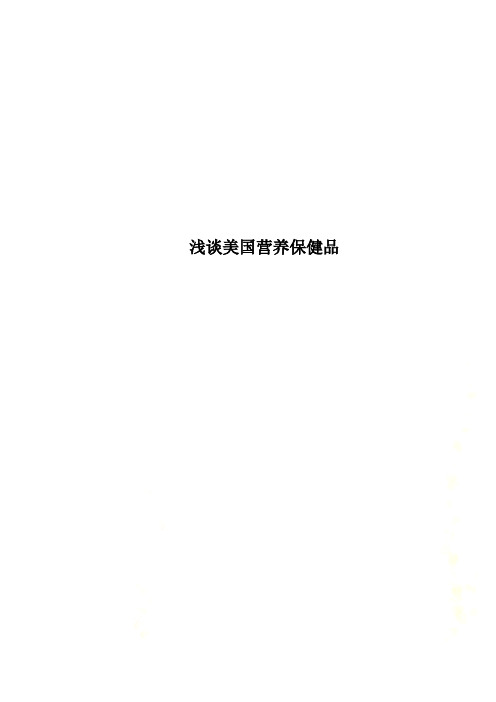
浅谈美国营养保健品浅谈美国营养保健品美国没有明确的“保健品”一词的提法。
大体上讲,美国的非处方药和食用营养补充剂等制品与中国的保健品在市场操作和具体使用方面均有一定的相似性。
在美国“保健品”是一个模糊的概念。
实际上,美国将天然有机食品、膳食补充剂以及形形色色的功能食品都列为所谓保健产品范畴。
而这其中只有Dietary Supplements(膳食营养补充剂,又称营养补充剂,简称营养剂)才是中国人视角里所理解的保健品。
膳食营养补充剂,又称营养补充剂,简称营养剂。
1994年10月,美国国会通过了克林顿总统签署的《膳食补充剂健康教育法令》(DSHEA),膳食补充剂(dietary supplement)从此获得了正式的法律定义:1、它是作为饮食的补充剂并含有下列一种或多种成分,包括:维生素,矿物质,蛋白质,药草或其它植物制剂(但不包括烟草),氨基酸,可以帮助增加每日进食量的补充剂,浓缩素,代谢物、组成物或提取物。
2、它是以片剂、胶囊、液体等形式供人摄入的。
3、它不能取代某种传统食物或成为饮食的唯一来源。
4、它需要明确标记为“diet ary supplement 膳食补充剂”。
5、它是具有多种调节人体机能的功能性。
美国食品及药物管理局(FDA)规定:膳食补充剂是一种食品,而不是一种药品。
因此,并不保证膳食补充剂的安全性和有效性。
只有在某种膳食补充剂出了问题后,FDA才会去调查它的生产商。
在美国,“膳食补充剂”即营养剂是区别于普通消费食品和药品的第三类产品。
这一类营养剂产品的级别又可分为:普通消费类和医生处方类。
对于营养剂的级别区分,无论是普通消费类还是医生处方类,都有由相应的、专门第三方检测公司认证考查。
普通消费类营养剂,是以基础综合类维生素营养剂为评比基准;而医生处方类营养剂则是由专业认证的医生提供使用反馈数据做为基准。
第三方检测公司会定期或不定期的向公众公告相关的评比数据。
一般普通消费类营养剂,人们除了可以在专卖店、购物中心购买之外,还可以通过邮购或直销等方式获得。
你每天吞下的保健品到底都是啥 美国常见保健品科普!
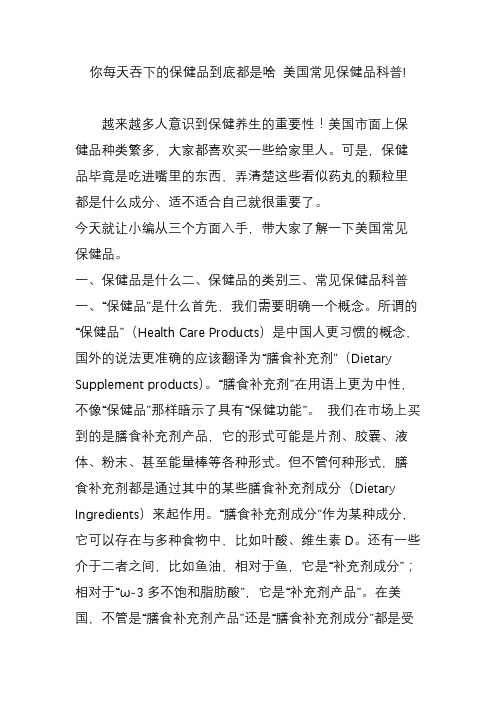
你每天吞下的保健品到底都是啥美国常见保健品科普!越来越多人意识到保健养生的重要性!美国市面上保健品种类繁多,大家都喜欢买一些给家里人。
可是,保健品毕竟是吃进嘴里的东西,弄清楚这些看似药丸的颗粒里都是什么成分、适不适合自己就很重要了。
今天就让小编从三个方面入手,带大家了解一下美国常见保健品。
一、保健品是什么二、保健品的类别三、常见保健品科普一、“保健品”是什么首先,我们需要明确一个概念。
所谓的“保健品”(Health Care Products)是中国人更习惯的概念,国外的说法更准确的应该翻译为“膳食补充剂”(Dietary Supplement products)。
“膳食补充剂”在用语上更为中性,不像“保健品”那样暗示了具有“保健功能”。
我们在市场上买到的是膳食补充剂产品,它的形式可能是片剂、胶囊、液体、粉末、甚至能量棒等各种形式。
但不管何种形式,膳食补充剂都是通过其中的某些膳食补充剂成分(Dietary Ingredients)来起作用。
“膳食补充剂成分”作为某种成分,它可以存在与多种食物中,比如叶酸、维生素D。
还有一些介于二者之间,比如鱼油,相对于鱼,它是“补充剂成分”;相对于“ω-3多不饱和脂肪酸”,它是“补充剂产品”。
在美国,不管是“膳食补充剂产品”还是“膳食补充剂成分”都是受FDA(食品及药物管理局,Food and Drug Administration)监管的。
在颁布于1994年的《膳食补充剂健康与教育法》(Dietary Supplement Health and Education Act,DSHEA)中,膳食补充剂被归在“食品”类,而不是药品类。
二、保健品的类别如果一定要笼统的给保健品分个类,可以尝试把它们分为两类。
一类是人体所需要的微量营养成分,比如各种维生素和矿物质。
人体中这些物质少了影响健康,多了也影响健康。
但有少数的营养成分,在某些人群中确实比较容易缺乏。
比如钙,体力需求量比较大、更年期后的女性、运动员、严格素食者等等,或者因为饮食中的钙含量不高,或者因为吸收率低,都比较容易处于钙缺乏的状态。
211142715_各国对蜂胶产品的监管情况
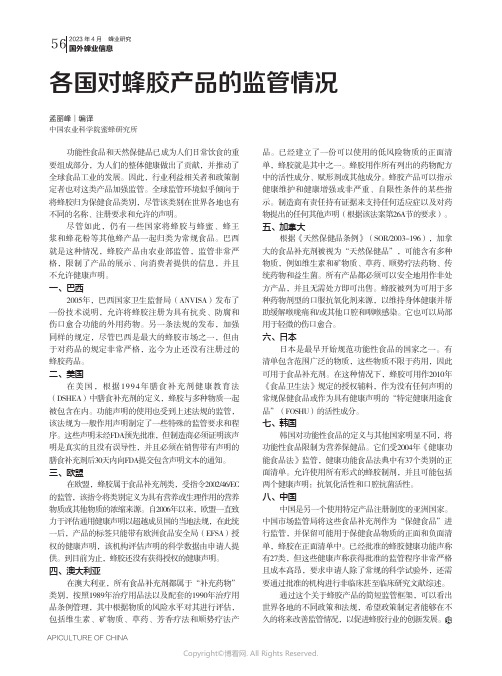
56APICULTURE OF CHINA国外蜂业信息2023年4月 蜂业研究功能性食品和天然保健品已成为人们日常饮食的重要组成部分,为人们的整体健康做出了贡献,并推动了全球食品工业的发展。
因此,行业利益相关者和政策制定者也对这类产品加强监管。
全球监管环境似乎倾向于将蜂胶归为保健食品类别,尽管该类别在世界各地也有不同的名称、注册要求和允许的声明。
尽管如此,仍有一些国家将蜂胶与蜂蜜、蜂王浆和蜂花粉等其他蜂产品一起归类为常规食品。
巴西就是这种情况,蜂胶产品由农业部监管,监管非常严格,限制了产品的展示、向消费者提供的信息,并且不允许健康声明。
一、巴西2005年,巴西国家卫生监督局(ANVISA)发布了一份技术说明,允许将蜂胶注册为具有抗炎、防腐和伤口愈合功能的外用药物。
另一条法规的发布,加强同样的规定,尽管巴西是最大的蜂胶市场之一,但由于对药品的规定非常严格,迄今为止还没有注册过的蜂胶药品。
二、美国在美国,根据1994年膳食补充剂健康教育法(DSHEA)中膳食补充剂的定义,蜂胶与多种物质一起被包含在内。
功能声明的使用也受到上述法规的监管,该法规为一般作用声明制定了一些特殊的监管要求和程序。
这些声明未经FDA预先批准,但制造商必须证明该声明是真实的且没有误导性,并且必须在销售带有声明的膳食补充剂后30天内向FDA提交包含声明文本的通知。
三、欧盟在欧盟,蜂胶属于食品补充剂类,受指令2002/46/EC 的监管,该指令将类别定义为具有营养或生理作用的营养物质或其他物质的浓缩来源。
自2006年以来,欧盟一直致力于评估通用健康声明以超越成员国的当地法规,在此统一后,产品的标签只能带有欧洲食品安全局(EFSA)授权的健康声明,该机构评估声明的科学数据由申请人提供。
到目前为止,蜂胶还没有获得授权的健康声明。
四、澳大利亚在澳大利亚,所有食品补充剂都属于“补充药物”类别,按照1989年治疗用品法以及配套的1990年治疗用品条例管理,其中根据物质的风险水平对其进行评估,包括维生素、矿物质、草药、芳香疗法和顺势疗法产品。
美国膳食补充剂健康与教育法(DSHEA 1994)简介
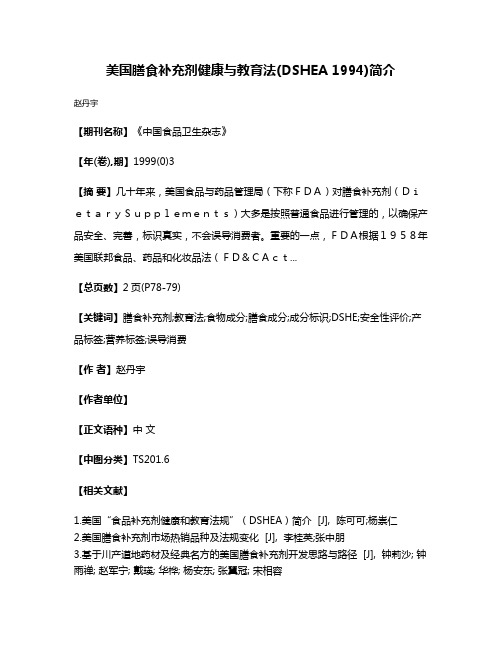
美国膳食补充剂健康与教育法(DSHEA 1994)简介
赵丹宇
【期刊名称】《中国食品卫生杂志》
【年(卷),期】1999(0)3
【摘要】几十年来,美国食品与药品管理局(下称FDA)对膳食补充剂(DietarySupplements)大多是按照普通食品进行管理的,以确保产品安全、完善,标识真实,不会误导消费者。
重要的一点,FDA根据1958年美国联邦食品、药品和化妆品法(FD&CAct...
【总页数】2页(P78-79)
【关键词】膳食补充剂;教育法;食物成分;膳食成分;成分标识;DSHE;安全性评价;产品标签;营养标签;误导消费
【作者】赵丹宇
【作者单位】
【正文语种】中文
【中图分类】TS201.6
【相关文献】
1.美国“食品补充剂健康和教育法规”(DSHEA)简介 [J], 陈可可;杨崇仁
2.美国膳食补充剂市场热销品种及法规变化 [J], 李桂英;张中朋
3.基于川产道地药材及经典名方的美国膳食补充剂开发思路与路径 [J], 钟莉沙; 钟雨禅; 赵军宁; 戴瑛; 华桦; 杨安东; 张翼冠; 宋相容
4.美国膳食补充剂管理研究及对中国的启示 [J], 田明;冯军;孙璐;王茜;周世伟;吴李娣
5.美国FDA批准螺旋藻提取物作为着色剂用于膳食补充剂 [J],
因版权原因,仅展示原文概要,查看原文内容请购买。
- 1、下载文档前请自行甄别文档内容的完整性,平台不提供额外的编辑、内容补充、找答案等附加服务。
- 2、"仅部分预览"的文档,不可在线预览部分如存在完整性等问题,可反馈申请退款(可完整预览的文档不适用该条件!)。
- 3、如文档侵犯您的权益,请联系客服反馈,我们会尽快为您处理(人工客服工作时间:9:00-18:30)。
美国膳食补充剂健康与教育法(DSHEA 1994)简介
几十年来 , 美国食品与药品管理局(下称 F DA)对 膳食补充 剂(Dietary Supplements)大 多是按照 普通食 品 进行管理的 , 以确保产品安全 、完善 , 标识真实 , 不会误导消费者 。 重要 的一点 , FDA 根据 1958 年美国联 邦食 品 、药品和化妆品法(FD &C Act)有关食 品添加 剂补充条 款对每 一种新 食物成 分的安 全性进 行评价 , 包括 膳 食补充 剂的 成分 。 然 而 , 1994 年膳 食补 充剂 健康 与教 育法(DSHEA)获 得通 过 , 随之 由国 会 修订 了 F D &C A ct , 其中包含了一些专门针对膳食补充剂和膳食补充剂食物成分的条款 。 这样 , 膳食补充剂的食物成分 再不 需像其他新食物成分或食物成分的新功用那样进行上市前 的安全性 评价 。 但它们 必须符合有 关的安全 性要 求。
DSHEA 的条款首先确定了膳食补充剂和膳食成分的范畴 ;建立了确保其安全性的新框架 ;明确产品销售 时所标识的文字要求 ;例举了几种有关功能和 营养的声明 ;指出有关 成分和营养 标签的要 求 ;委托 F DA 负 责 起草有关 G M P 条例 。 DSHEA 还要求在国家卫生院(N ational I nstitutes of Health)建 立一个膳食补充剂标签委 员会和膳食补充剂办公室 。 以上内容将在后面详述 。
DSHEA 要求成立一个膳食补充剂委员会负责进行有关 膳食补充剂 的研究和 标签宣传的 管理 , 并制定 评 价各种功能宣传的程序 。 委员会的成员应确定如何更好地 评价产品的 宣传是真 实的 、科 学上有效 的 、不会 误 导消费者的咨讯 , 以便使消费者作出明智的和正确 的选择 。 委员 会成员包括 来自生产 、研究 、管理 、销售和 使 用的各方人员 。
— 78 —
中国食品卫生杂志 第 11 卷第 3 期
相关资料 DSHEA 提供了一些获得“第三方” 材料的途径 , 这些材料有助于消费者了解有关膳食补充剂的健康益处 。
它包括文章 、节选 、科学摘要或其他第三方的出版物等 。 DSHEA 的相关条款特别强调这些信息不得是 错误或 误导性的 ;不得针对某个产品品牌进行宣传 ;必须与其他资 料一道展示 科学平衡 的观点 ;必须与产 品分开 ;产 品上不得附有其他信息(如产品促销资料等)。
(赵丹宇 编译)
食用工业猪油引起食物中毒事件的思考 ——— 田永张 李光明 柳其芳等
— 79 —
1994 年 10 月 25 日 DSHEA 认识到的目的是许许多多消费 者认为膳食 补充剂 有助于 提高每日 的膳食 水 平并会带来健康益处 。 DSHEA 保证这类食品的安全性和正 确的标识 , 为生产 和食用这类 产品的人 员提供 指 导 。DSHEA 同时指出 , 还需要进一步科学 研究证 实完善 的膳食 与健康 之间可 能存 在的促 进关 系 , 但目前 来 讲 , 膳食补充剂与减少保健费用和疾病预防等 确实存在某种联系 。
营养学论点 DSHEA 提出了可在膳食补充剂产品上使用的各种类型 的声明 , 但这些声 明(宣 传)不 得是某种 膳食补 充 剂与疾病诊断 、预防 、缓解和治疗的关系(除非有 关新药条 款已经 F D &C Act 批准)。 例如 , 产品不得 宣称“ 治 疗癌症” 或“ 治疗关节炎” 。 经 F DA 批准的几种健康宣传 , 如“ 叶酸与 降低新生儿 神经管缺 陷的危险” 和“钙 与 降低骨质疏松的危险”等 , 可以用在符合宣传要求的产品 , 作为标签的补充 。 根据 DSHEA , 厂家还可在 产品上 介绍有关营养素缺乏病的情况 , 只要这些说明 能够提出这类疾 病在美国 的发病资料 。 另 外 , 厂 家还可就膳 食 补充剂对机体结构和功能 , 甚至全面健康的影 响进行宣传 。 在进行 所有以上 宣传时 , 生产厂家 必须提供资 料 证实其真实性且不会误导消费者 , 而且产品标 签上还应附有这样一段话 :“ 本产品未经 FDA 评价 , 本产品 不能 用于诊断 、治疗或预防疾病” 。 这类营养上的宣传在产品上市前不需要经 F DA 审批 , 这点与“ 健康宣传” 不同 。 成分标识和营养信息标识
新膳食成分 膳食补 充剂中的新膳食成分是指在 1994 年 10 月 15 日 前未在 美国 上市的 物质 。 这 些物 质添 加到食 物 中 , 应确保原食物的化学性质不发生改变 , 或者它在以往使用中 、在推荐条件下使用能保证产品足够安全 。 生 产这类产品的厂家需在上市前 75 天向 F DA 提出申请 , 提交的材料应尽可能使 F DA 作出“可保 证产品足 够安 全” 的结论 。 良好生产工艺(GM P) DSHEA 提出由 F DA 负责起草有关膳食补充剂制备 、包装和存 放等方面的 GM P 法规 , 以确保其 安全性 。 该法规可在目前其他产品的 GM P 法规实施后制定 。 FDA 准备 会同其他工业部门和有关人士一道 制定 , 并届 时征求公众的意见 。 膳食补充剂委员会
膳食补充剂定义 过去 , FDA 只是将必需营养素 , 如维生素 、矿物质和蛋白 质作为膳 食补充 剂的成 分 。 1990 年营 养标签 和 教育法(N LEA , 1990)将“ 草本植物或类似 的营养物 质” 也列 入膳食 补充剂中 。 而这之 后的 DSHEA 将“ 膳 食 补充剂” 范畴扩大到必需营养素以外的如人参 、大蒜 、鱼 油 、车前草 、酶 、腺体以及所有以上物质的各种混合物 。 DSHEA 将膳食补充剂的正式定义用几个基本要求进行说明 , 即“膳食补充剂” 是 : ·一种旨在补充膳食的产品(而非烟草), 它可能含有一种或多种如下膳食成分 :一种维生素 、一种矿物质 、 一种草本(草药)或其他植物 、一种氨基酸 、一种用以增加每日总摄入量来补充膳食的食物成分 , 或以上成分的 一种浓缩品 、代谢物 、成分 、提取物或组合产品等 。 ·产品形式可为丸剂 、胶囊 、片剂或液体状 。 ·不能代替普通食物或作为膳食的唯一品 种 。 ·标识为“ 膳食补充剂” 。 ·一种得到批准的新药 、一种得到发证的抗生素或一种得到许可的生物制剂 , 如在其分别得到批准 、发证 、 许可前已作为膳食补充剂或食品上市的产品(美国卫生与人类事务部 SHHS 豁免该条款的情况除外)。 安全性 DSHEA 修订了原 F D &C A ct 中 有关食物搀假的条款 。 根据 DSHEA , 某种膳食 补充剂如果它本身或其中 某些成分在标签指示下食用或在正常情况下食用(如无食用指示)具有明 显的或过 度的引起疾 病或损伤 的危 险 , 那么它就视为搀假产品 。 某种膳食补充剂中 所含有的 新食物 成分(如 :1994 年 10 月 15 日前未 作为膳 食 补充剂在美国上市的食物成分)如缺乏充分资 料 , 不足以保证其不会引起明显或过度的疾病或损伤 危险 , 那么 它也被视为搀假 。 美国卫生与人类事务部(SHHS)公布哪些膳食 补充剂或食物成分对人类健康和安全造成直 接危害 。 但如同其他食品一样 , 保证产品上市前的安全 性和标签的正确标识是生产者的责任 。
膳食补充剂和其他产品一样 , 必须有成分 标识 。它 包括每一种食物成分的名称和用量 , 针对复合产品 , 还 应有所有膳食成分(不包括非活性成分)的总量 。 产品 标签上 应有“ 膳食 补充剂” 字样(如 , “ 维生素 C 膳食 补 充剂”)。产 品中如有草本植物成分 , 应说明其成分来源的植物部 位 。如果 某种膳食补充剂是官方颁布的规格 目录(这包括美国药典 、美国顺势疗法药典 、国家处方集 等)中的一种 , 那么它必须符合其有关规格要求 。 如果 不是上述官方颁布的规格目录中的品种 , 这种 膳食补充剂也必须与标签上标出的相符且具有所表明的效力 。
产品标签上还应有营养标识 。 营养标识中将 F DA 确定了每 日推荐摄入 值的膳食 成分列 在前面 , 无每 日 推荐摄入值的成分列在后 。 用量少的膳食成分无需标注 。 营 养标识还包 括每种膳食 成分在每 份食物中的 含 量以及该膳食成分的来源(如 , “钙 来自葡 萄糖酸钙”)。 凡在营 养标识 中标示 出的成 分无需在 成分 标识中 列 出 。 产品标签中 , 营养标识应在成分标识之前 。
